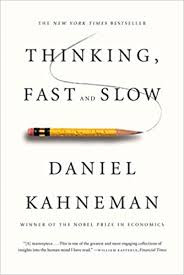Book Review of Thinking, Fast and Slow by Daniel Kahneman

Have you ever felt like banging your ahead
against the wall for any decision you made, going by your intuitive judgment?
Have you ever wondered why putting up a big smile on your face when you are
downcast, enlivens your mood? Have you ever thought why a single failed
decision of a successful person tumbles his/her reputation like a pack of
cards? Many such questions similar in line to the aforementioned, often props
up in our mind. Daniel Kahneman, a Nobel Laureate has nailed them all in his
book Thinking, Fast and Slow (Penguin Press Non-Fiction). The book is quite voluminous; but, trust me, it answers almost all questions
about the biases and heuristics that influence a person in making a decision,
which makes this book worth a read.
The chapters are neatly segmented and grouped under 5 parts. Each part revolves around a theme. The author introduces the reader to a laundry list of jargons, which you feel too much to assimilate as you progress. At the end of each chapter, illustrations are provided to reinforce the learning of the chapter. He introduces two-system approach: System 1, that which thinks fast; System 2, that which thinks slow. A leitmotif of this book is the interplay between these 2 systems. Throughout the book, he talks about these 2 systems and draws out the differences between the two. He illustrates the autonomy of the System 1 using the famous Muller-Lyer illusion. There is a conflict between our impressions and beliefs. The one that eventually dominates depend on the influence of the cognitive illusion that a person is under. System 2, which is generally lazy, is the one that can follow rules, compare objects and make choices. The system that comes to the rescue of the person when he/she is confronted with a question is entirely dependent on that individual.
He reiterates that one knows far less about oneself than one feel one does. You will find the veracity of his belief all the more relevant, after reading this book. The author then introduces an acronym: “WYSIATI”, which stands for What You See Is All There Is. System 1 is good at constructing the best possible story with the data that is currently available in one’s memory. The amount and quality of data on which the story is based are largely irrelevant. Daniel tears apart the veil that each of us showcase.
All of us think that we are rational thinkers and an expert in making decisions. But deep within, there are myriad biases and effects that influence us viz., Outcome bias, Halo effect, priming effect, ideometer effect etc., .
One will be bewildered to know that one’s thought and
behavior may be influenced by a stimuli to which one pays no attention at all.
The author backs all these findings with his surveys.
The author asserts that the readers are more likely to learn something by finding surprises in one’s own behavior than by hearing surprising facts about people in general. Daniel, being an economist, goes on to describe famous statistical concepts like regression to mean and correlation coefficient to explain how luck plays the spoilsport. This is why, many a times, HRs fret out with anxiety that very best candidates may fail to meet the expectations of the organization.
How does one react when given a choice between sure loss and a gamble(win or lose)? To answer this crucial question, the author has dedicated a part in his book. Most of us make a choice in life and regret over the outcome of it. Daniel suggests a hindsight-avoiding policy to inoculate oneself against the regret. He says it is useful to be explicit about the anticipation of regret and just be completely casual when making a decision with long-term consequences. Finally, he talks about two selves: remembering self and experiencing self. A misfit climax in a good movie will leave a bad memory(the former),but that doesn’t debunk the experience one had(the latter).
Overall, it wouldn’t be an overstatement if I call this book as a cornucopia of wisdom. If you ever want to pick a behavioral economist’s brain, go pick this book. With his uncanny knack, Daniel subtly suggests doable techniques which one can make use of when making key decisions. It will help one to look at things in a different perspective.
You could grab your copy here:
Newsletter
About Sammy's MindChirps
Hello! Welcome to Sammy's MindChirps. I'm glad you are here. To me, the word LIFE is an acronym of Laboratory with Infinite Freedom to Experiment. It's more like a kaleidoscope offering amazing learning opportunities as we grow and explore various facets of life. So this blog is a platform where I share anything that I find interesting (with my two cents, of course :D). I assure that you will have some new learning when you exit the blog. And do share your feeback on the blog or anything you want me to write about in this blog by dropping an email to mindchirps@gmail.com